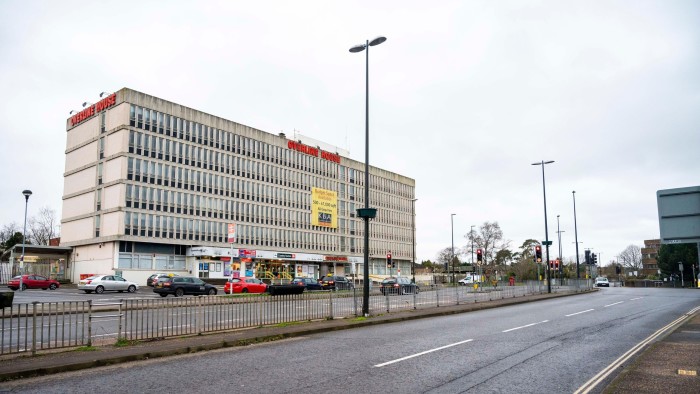The UK secondary office market — lower quality offices, or those in locations that have gone out of fashion — is in a tough spot. Prices are falling, attracting tenants is difficult as work habits change, and a surge in construction costs has made it more expensive to convert the buildings to another use.
“There are a load of buildings in the office market that are secondary and are no longer fit for purpose,” says Hugh White, head of national capital markets at BNP Paribas Real Estate. “There’s a lot of small business parks or standalone buildings that have just had their time.”
According to Mat Oakley, director of commercial research at estate agent Savills, “for grade B properties in grade B or C locations there’s probably no exit, other than alternative use.”
One significant driver has been the pandemic. Industry insiders say many corporate tenants no longer favour a model of having a headquarters in a big city such as London, then other offices in smaller satellite towns that workers can more easily commute to.
Risk management: Property
The article is part of a special report on risk management in the property sector. Other pieces cover fire risks, cyber threats, and building safety.
Instead, they prefer a larger central office where all staff can work three days a week, with the other two at home. Often they want these properties to be high quality, with facilities such as cycle parking, showers or a roof terrace.
This shift has sent prime London office rents surging but is proving bad news elsewhere. Towns in south-east England such as Redhill, Reigate and Crawley are among those named by industry executives as less popular with some tenants, as are out of town business parks.
Michael Wiseman, head of campuses at British Land, says location “has never been more important” for the prospects of letting a building.
“A ‘good bones’ [well constructed] building in the right location is pretty attractive,” he says. “A secondary building in a secondary location becomes harder. There are definitely challenges in those parts of the market.”
From the end of 2010 to June this year, the price of offices in the south-east, excluding London, has dropped 26 per cent, according to MSCI, whereas the price of central London offices has risen 32 per cent. Weighing on prices has been the waning of institutional investor interest in offices, which a decade or two ago would have been a core holding in a pension fund’s real estate portfolio.
In a sign of the demand for higher quality properties, the proportion of grade A offices let in the City of London as of the second quarter of this year was 76.3 per cent, compared with just under 70 per cent of grade B properties, according to BNP Paribas Real Estate and CoStar.
In the so-called Big Six — Leeds, Manchester, Birmingham, Bristol, Edinburgh and Glasgow — more than 75 per cent of grade A space was let, compared with 65.5 per cent of grade B.
Adding to the problem for owners of secondary offices is a surge in the costs of refurbishment or repositioning a building to a different use, as prices of materials and labour have risen.
Since August 2013 — when a rule change made it easier to convert commercial property to residential — the cost to a developer of an office refurbishment has risen 96 per cent, according to the Building Cost Information Service.
Combined with the sharp downturn in the market, that means, for many asset owners, there are no easy solutions.
“A ‘do nothing’ approach is going to hurt you,” says Henry Wyld, partner at real estate consultancy Knight Frank. “If you’re waiting for the market to bounce back, it’s not going to happen.”
Repositioning an office “offers optionality and liquidity”, but it is “no silver bullet”, he adds. “The valuation hit is real, and it’s going to be real no matter what you do in terms of repositioning.”
In some cases, modernising offices can give them a new lease of life, although usually only if they are in sought-after locations.
Real estate manager Henderson Park bought Woolworth House in central London, the former UK headquarters of retailer Woolworths, in 2018 and is refurbishing the 1950s building for completion later this year. The new offices are expected to be net zero carbon, with a gym, events space and roof terrace. Henderson Park says it expects to achieve about a 70 per cent increase in rents as a result.
And in the Berkshire town of Newbury, Oval Real Estate is refurbishing three buildings on a campus built in 2002 for Vodafone, including building a lakeside restaurant and fitness centre.
“The opportunity exists to buy well-located grade C, and you can capture quite a bit of the rental uplift,” says Martin Towns, global head of real estate at M&G, which is refurbishing Equitable House on King William Street in the City of London.
However, some investors are finally seeing signs of a rebound in regional towns and cities, as high rents in prime locations drive occupiers to look further afield.
Regional Reit, which holds property in the UK’s regions, has recently sold offices in High Wycombe for redevelopment as residential and in Bracknell for mixed commercial use. But Stephen Inglis, chief executive of London & Scottish Property Investment Management, says refurbishment is becoming more attractive.
“We’ve identified buildings in the portfolio that we were going to sell for alternative use [and now instead refurbish them]. We’re in discussions with a number of big occupiers to put them into parts of our portfolio that are [currently] unrefurbished,” he says.




